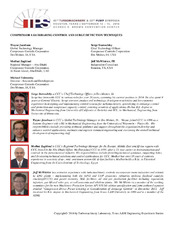| dc.contributor.other | Turbomachinery Symposium (45th : 2016) | |
| dc.creator | Jacobson, Wayne | |
| dc.creator | Staroselsky, Serge | |
| dc.creator | Zaghloul, Medhat | |
| dc.creator | McWhirter, Jeff | |
| dc.creator | Tolmatsky, Michael | |
| dc.date.accessioned | 2017-03-14T21:29:15Z | |
| dc.date.available | 2017-03-14T21:29:15Z | |
| dc.date.issued | 2016 | |
| dc.identifier.uri | https://hdl.handle.net/1969.1/159801 | |
| dc.description | Tutorial | en |
| dc.description.abstract | Centrifugal compressor trains operating in parallel or series arrangements are complex when it comes to turbomachinery control. Methodologies for controlling compressor trains in these arrangements piping layout considerations to be observed is discussed. Surge in centrifugal and axial compressors often manifests itself as oscillations of flow and pressure, as well as related compressor parameters, such as rotating speed. Many of the devices, which incorporate surge detection function, use either the location of the operating point relative to the Surge Limit Line (SLL) or physical manifestations of surge, such as high rates of changes of selected process signals for identifying surge. This paper analyzes surge signatures collected in the field and outlines several approaches to surge detection using a combination of parameters, such as flow and discharge or suction pressure, based on the type of application. | en |
| dc.format.medium | Electronic | en |
| dc.format.mimetype | application/pdf | |
| dc.language.iso | en | |
| dc.publisher | Turbomachinery Laboratories, Texas A&M Engineering Experiment Station | |
| dc.relation.ispartof | Proceedings of the 45th Turbomachinery Symposium | en |
| dc.subject.lcsh | Turbomachines | en |
| dc.title | Compressor Loadsharing Control And Surge Detection Techniques | en |
| dc.type.genre | Presentation | en |
| dc.type.material | Text | en |
| dc.format.digitalOrigin | born digital | en |
| dc.identifier.doi | https://doi.org/10.21423/R16P4J | |


